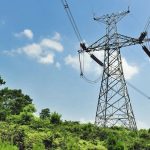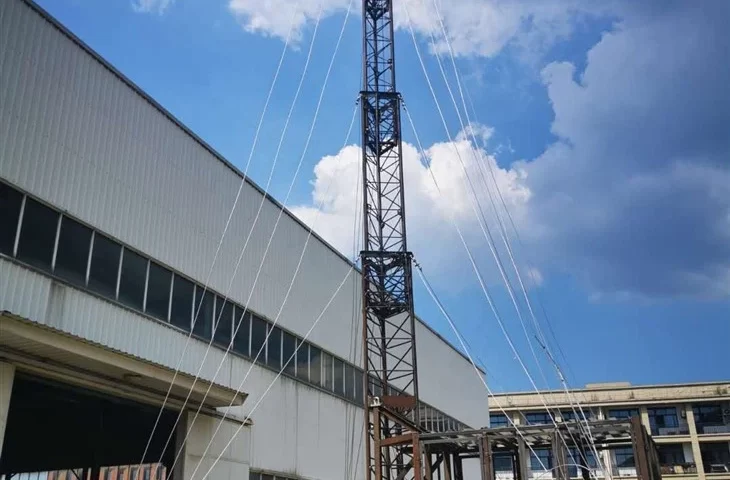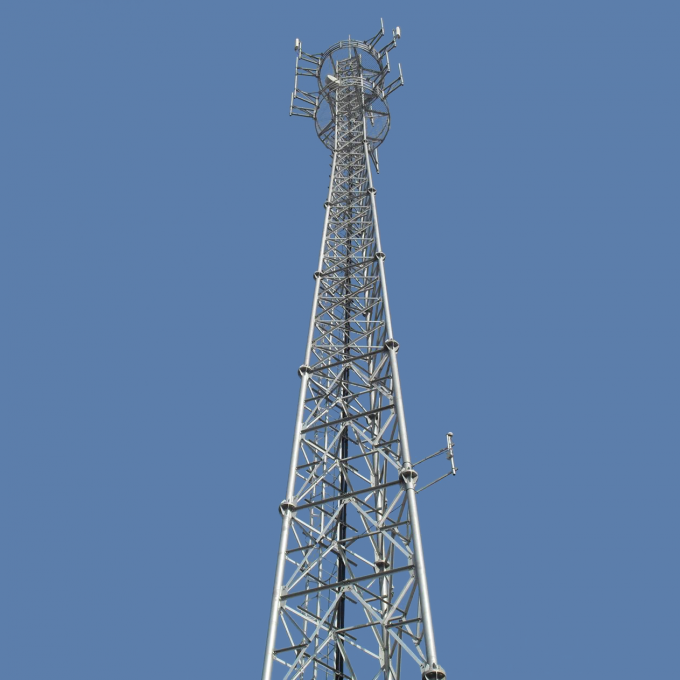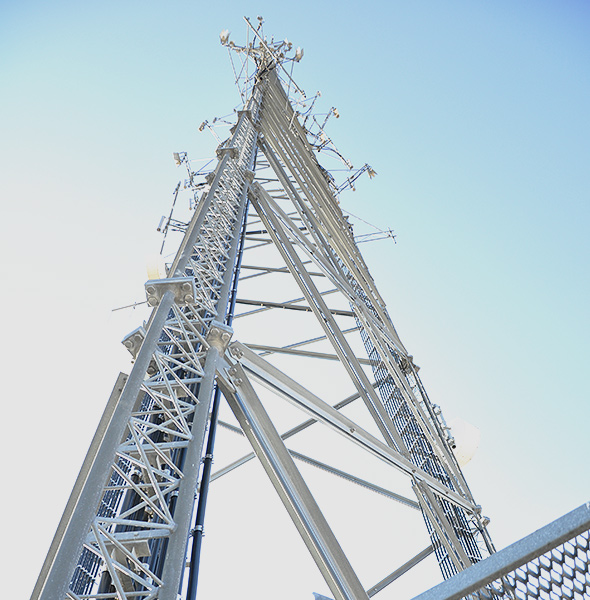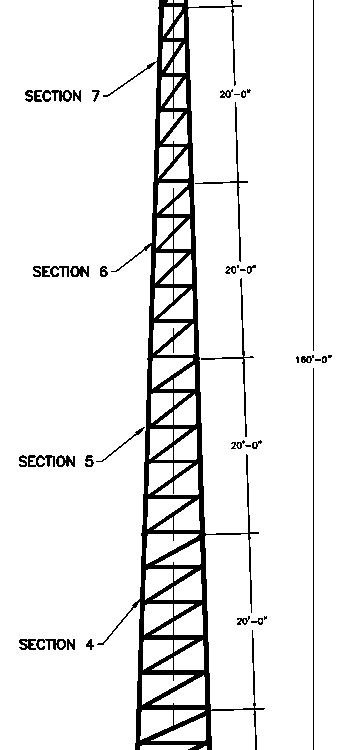Self-guying portable mobile antenna steel towers are designed to provide reliable and robust support for communication antennas in temporary or remote locations. Unlike traditional towers that rely on external guy wires for stability, self-guying towers maintain balance using their intrinsic structural design. This makes them ideal for scenarios requiring quick deployment without compromising performance.
In today’s fast-paced, connectivity-driven world, these towers play a pivotal role in enabling seamless communication during emergencies, eventos al aire libre, or military operations. With their portability and ease of installation, they are indispensable assets in temporary communication setups.
Evolución de las torres de acero de antenas móviles
From Fixed Structures to Portable Solutions
Inicialmente, antenna towers were built as fixed structures, requiring significant groundwork and time for setup. Si bien es efectivo, these towers lacked the flexibility to cater to temporary needs.
Rise of Portability
The advent of portable solutions began in response to the growing demand for communication during emergencies and events. Innovations in engineering and materials led to the development of lightweight yet sturdy self-guying designs.
Integration of Modern Technology
Today’s self-guying portable mobile antenna towers leverage cutting-edge technology to offer improved stability, adaptabilidad, and rapid deployment capabilities. From automated assembly to enhanced wind resistance, the evolution continues to meet the demands of modern applications.
Componentes de torres de antenas móviles autoguiadas
Understanding the key components of these towers highlights their functionality:
- Steel Framework: Made from high-grade steel, ensuring durability and resistance to environmental stress.
- Base Structure: un amplio, stable base supports the tower without requiring external anchors or guy wires.
- Antenna Mounts: Adjustable mounts accommodate various types of antennas for diverse communication needs.
- Compact Transport Modules: Designed for easy transport and storage, these towers can be folded or dismantled.
Características clave de las torres de antenas móviles portátiles autoguiadas
Self-Guying System
The self-guying mechanism eliminates the need for external guy wires, reducing setup time and space requirements.
Durabilidad de los materiales
Constructed with corrosion-resistant steel, these towers can withstand harsh weather conditions, including rain, nieve, and high winds.
Ease of Transport and Assembly
Lightweight sections and modular designs make these towers easily transportable and quick to assemble, even in remote areas.
Adaptability to Various Terrains
Whether deployed on uneven ground or solid surfaces, these towers feature adaptable bases to ensure stability.
Tipos de torres de antena autoguiadas
- Fixed Portable Towers: Ideal for events or temporary installations that do not require frequent relocation.
- Adjustable Height Towers: Feature telescopic sections to accommodate varying height requirements.
- Lightweight vs. Heavy-Duty Models: Tailored to specific applications, from small-scale setups to high-wind environments.
Applications of Portable Mobile Antenna Steel Towers
Emergency Communication Setups
In disaster scenarios, these towers enable quick restoration of communication networks, providing vital links for rescue operations.
Temporary Installations for Events
From concerts to sporting events, Las torres portátiles facilitan la comunicación fluida y la transmisión en vivo..
Military and Defense Operations
Self-guying towers are extensively used in military operations to establish temporary communication networks in remote or hostile terrains.
Disaster Relief Scenarios
During natural disasters like hurricanes or earthquakes, these towers ensure connectivity for relief agencies and affected communities.
Benefits of Self-Guying Antenna Towers
- Quick Deployment: Requires minimal setup time, making them ideal for emergencies.
- Diseño que ahorra espacio: Compacto y portátil, they require less storage space and operational area.
- Eficiencia de costo: Eliminates the need for extensive groundwork, reducing overall costs for short-term projects.
- Versatilidad: Compatible with various antenna types and communication equipment.
Comparison with Traditional Antenna Towers
| Característica | Self-Guying Towers | Torres Tradicionales |
|---|---|---|
| Setup Time | Rápido (< 1 día) | Largo (several days/weeks) |
| Estabilidad | Built-in self-guying system | Relies on external guy wires |
| Portabilidad | Alto | Bajo |
| Mantenimiento | Mínimo | Requires regular upkeep |
| Costar | Cost-effective for short-term | Expensive for temporary use |
Materials and Construction Standards
High-Grade Steel Properties
- Ensures maximum strength and stability.
- Lightweight yet durable for easy transport.
Resistencia a la corrosión
Special coatings and galvanization protect against rust and weather damage.
Compliance with Industry Standards
Adheres to global safety and construction regulations for communication towers.
Factors to Consider When Choosing a Tower
- Capacidad de carga: The ability to support antennas and additional equipment.
- Resistencia al viento: Stability in high-wind conditions.
- Altura: Determines the coverage area of the antennas.
- Portabilidad: Ease of transport and storage.
- Presupuesto: Aligns with project-specific financial constraints.
Installation and Maintenance Guide
Pre-Installation Checks
- Assess terrain and weather conditions.
- Verify equipment and components.
Step-by-Step Setup Process
- Unpack the tower components.
- Assemble the base structure.
- Secure the self-guying mechanism.
- Mount the antenna and related equipment.
Regular Maintenance Tips
- Inspect for corrosion or wear.
- Tighten bolts and connections periodically.
Challenges in Deploying Self-Guying Antenna Towers
- Terrain Adaptability: May require additional stabilization on uneven ground.
- Transport Logistics: Large models may need specialized vehicles.
- Condiciones climáticas: Extreme environments can affect performance.
Technological Advancements in Portable Towers
- Automation in Deployment: Systems that deploy at the push of a button.
- Enhanced Stability Mechanisms: Incorporating dynamic stabilization technology.
- Materiales avanzados: Compuestos livianos para una mejor portabilidad.
Market Overview and Leading Manufacturers
Demanda mundial
Las crecientes necesidades en gestión de emergencias y comunicación remota impulsan el crecimiento del mercado.
Jugadores clave
- Industrias sable
- Industrias Valmont
- Soluciones de torre galvanizada
Tendencias futuras
Centrarse en la sostenibilidad y el peso ligero, materiales duraderos.
FAQs about Self-Guying Portable Mobile Antenna Steel Towers
- What makes a self-guying tower portable? El diseño compacto y el montaje modular permiten un fácil transporte.
- How durable are steel towers for long-term use? El acero de alta calidad garantiza la longevidad incluso en entornos difíciles.
- Can they be used in extreme weather conditions? Sí, Están diseñados para soportar fuertes vientos y fuertes precipitaciones..
- What is the average height of a portable tower? Normalmente oscila entre 20 a 100 pies, dependiendo del modelo.
- How is a self-guying system maintained? Las inspecciones periódicas y las reparaciones menores mantienen el sistema en óptimas condiciones..
- Are they suitable for permanent installations? Aunque principalmente para uso temporal, Ciertos modelos pueden servir como soluciones permanentes..
Las torres de acero para antenas móviles portátiles autoportantes representan una solución transformadora para las necesidades de comunicación modernas. Su portabilidad, facilidad de uso, and robust design make them essential in diverse applications, from emergency response to large-scale events. A medida que avanza la tecnología, these towers will continue to redefine the standards for temporary communication infrastructure.


